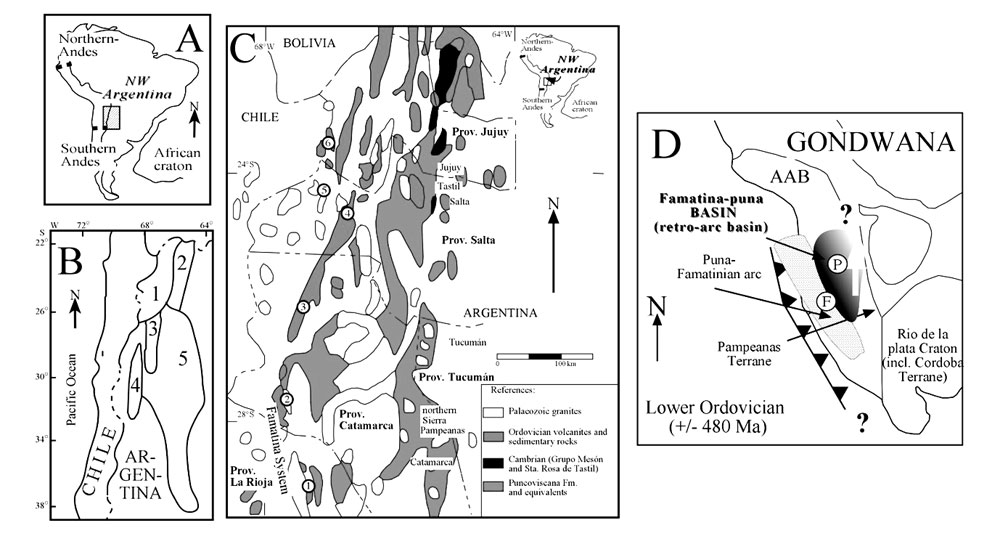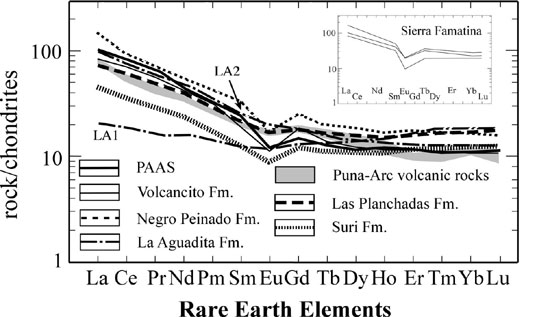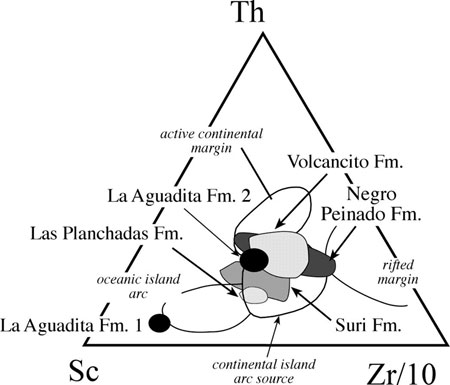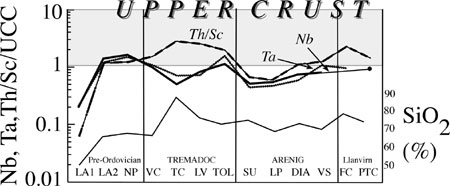
Depositional history of the Ordovician Famatina Basin (western Gondwana; NW Argentina)
Udo Zimmermann1, Heinrich Bahlburg2 and Susana B. Esteban3
1 Department of Geology, RAU University, Auckland Park 2092, South Africa. E–mail: uz@na.rau.ac.za
2 Geol.-Pal. Institut, Universität Münster, Corrensstr. 24, 48149 Münster, Germany. E–mail: bahlbur@uni-muenster.de
3 INSUGEO, Universidad Nacional de Tucumán, Miguel Lillo 205, 4000 Tucumán, Argentina. E–mail: insugeo@unt.edu.ar
Key word: Stratigraphy. Depositional model. Gondwana. Famatina Basin. Argentina.
Introduction
The study forms part of a project to model source and depositional areas, and the paleotectonic history of Cambrian to Ordovician deposits in the Famatina Range, NW Argentina (Figure 1). The presented data are compared with those of Ordovician deposits of the Puna basin (Figure 1B, C). The oldest sedimentary rocks of the Famatina basin are mainly fine–grained siliciclastic turbidity currents of the Neoproterozoic to Cambrian Negro Peinado and La Aguadita formations (Figure 1 C, Nº 1). Based on petrography and mainly major geochemistry, the successions are interpreted as deposited on a passive continental margin (Rossi et al., 1997). These successions are followed by the Volcancito Formation (Figure 1C, Nº 1; Harrington and Leanza, 1957), which was deposited during the uppermost Cambrian until the Upper Tremadoc (Esteban, 1999). Pankhurst et al. (1998) confirm a Tremadocian magmatic activity (SHRIMP data 490 +/– 5 Ma) related to a subduction zone setting at a continental margin. The volcanic influence is represented in the volcanogenic Suri, Las Planchadas (Figure 1C, Nº 2; Mángano and Buatois, 1996) and Portezuelo de las Minitas Formations (Aceñolaza and Gutiérrez–Marco, 2000). Mainly major element geochemistry was carried through by Clemens and Miller (1996) to determine an island–arc–related setting for the volcaniclastic rocks. The youngest sedimentary rocks were deposited during Upper Arenig to Llanvirn (Molles Formation, Harrington and Leanza, 1957).
Results
Geochemical data, especially trace element, including REE, concentrations are used to interpret the results under modern aspects of provenance analysis (e.g., McLennan et al., 1993; Bahlburg and Floyd, 1999). Major element data for all formations show that the CIA (Chemical Index of Alteration; Nesbitt and Young, 1982) is elevated (between 63 and 82) and the concentrations of provenance relevant major elements are strongly disturbed, according to Lower Paleozoic deposits in the Puna (see Figure 1B, Nº 1; Bahlburg, 1998; Zimmermann and Bahlburg, in press). The La Aguadita (sampling site: Quebrada de Paimán en el norte de Famatina) and Negro Peinado Formations (sampling site: Alto Carrizal, S28°51’45,3’’ W67°35’55,6’’) show differences, both in provenance and composition. The rocks of the La Aguadita Formation have to be divided in two groups. One group (LA1) shows a provenance from a mafic source, where the second group (LA2) comprises typical upper continental crust signatures. Group 2 shows enriched values in Nb and Ta related to the Upper Continental Crust averages (UCC after McLennan (2001): Nb= 12 ppm, Ta= 1 ppm; averages: La Aguadita Formation= 16,5 ppm Nb, 1,16 ppm Ta; Negro Peinado Formation= 18,08 ppm Nb, 1,39 ppm Ta). The low concentrations in Zr and Hf, mostly entirely concentrated in the mineral zircon, point to a sorting effect. The relatively low Th/Sc (around 1) are based on high Sc concentrations for continental crust derived rocks. During the Cambrian to the Lowermost Ordovician the Volcancito Formation (sampling site: Rio Volcancito, Bordo Atravesado) was deposited in a low energy environment, partly affected by wave energy or storm events (Zimmermann and Esteban, 2002). The Volcancito Formation shows geochemical affinities to the Negro Peinado deposits, with depleted concentrations of Th, Hf and Zr, and enrichment in Sc. During the Arenig the Famatina basin was dominated by subduction related volcanism. The volcaniclastic Suri (sampling site; Chaschuil, S27°47’48,9’’, W68°03’39,9’’) show a rhyodacitic to dacitic and the volcanogenic Las Planchadas Formation (sampling site: Chaschuil, S27°47’22,1’’, W68°04’18,9’’) a dacitic to andesitic composition, both a strong negative Ta–Nb anomaly (average Ta for both formations 0,4 – 0,5 ppm; average Nb 6 ppm), ratios for La/Th (Suri Formation= 3,41; Las Planchadas Formation= 2,99), La/Sc (Suri Formation= 1,60; Las Planchadas Formation= 1,57), Th/Sc (Suri Formation= 0,84; Las Planchadas Formation= 0,43) and Zr/Sc (Suri Formation= 10,96; Las Planchadas Formation= 9,34) typical for volcanic arc settings (McLennan et al., 1993). Petrographically, both Famatinian volcanogenic formations are more immature than their Puna volcaniclastic counterparts of Arenigian age. The influence of non–volcanic detrital material is small. Middle Ordovician formations of the Famatina Range that show the extinction of the volcanic arc, like the Llanvirnian Falda Ciénaga Formation or the Puna Turbidite Complex in the Puna (Bahlburg, 1998; Zimmermann et al., 2002) are not exposed. REE (Rare Earth Element data) show for all five formations relatively similar patterns to PAAS (Post–Archaen Australian average Shale), only the LA1 rocks show a very flat pattern. The volcanogenic rocks of the Las Planchadas Formation comprises in some samples a slight positive anomaly of Eu with slightly depleted LREE and enriched HREE, similar to Ordovician volcanogenic rocks in the Puna (Figure 2A).

Figure 1. A. Location of study area. B. Geological provinces units of NW Argentina (from Rapela et al., 1992). C. Outcrop localities discussed here: 1=Famatina (Alto Carrizal, Paimán; Negro Peinado and La Aguadita Fms.), 2=Chaschuil (Suri and Las Planchadas Fms.), 3=Sierra Calalaste (Diablo Fm.), 4=Salar de Pocitos (Tolar Chico and Tolillar Fms.), 5=Salar de Rincón (Las Vicuñas Fm.), 6= Huaytiquina area (Jama, Guayaos, Volcanosedimentary Successions, Aguada de la Perdiz Fm.). D. Proposed model for the Famatina–Puna retro–arc basin.


Figure 2. A. Rare Earth element pattern normalized to chondrite after Taylor and McLennan, 1985) of the Famatina rocks compared withPAAS (Post–Archaean Australian average Shale) and arc–related Ordovician rocks of the Puna (data from Zimmermann and Bahlburg, in press). B. Provenance plot after Bhatia and Crook (1986) using Sc, Zr, Th.

Figure 3. comparisons of trace elements and trace element ratios to demonstrate the basin evolution. Upper crustal values of Nb, Ta and Th/Sc are dominant during pre–Ordovician time and in the Llanvirn. During the arenig the influence of a continental arc source is obvious. Low concentrations in Nb and Ta in the Tolar Chico Fm. Are caused by dilution effects, note the extreme high silica content. The mafic rocks of the La Aguadita Fm. (LA1) point to a mafic source, which disappeared during the evolution of the Famatina–Puna basin. (Formation abbreviations: LA= La Aguadita, NP=Negro Peinado, VC= Volcancito, TC=Tolar Chico, TOL=Tolillar, SU=Suri, LP=Las Planchadas, DIA= Diablo, VS= volcanosedimentary Successions, FC= Falda Ciénaga, PTC=Puna Turbidite Complex; data for the PTC and VS from Bahlburg, 1998 and Bock et al., 2000, for VC from Zimmermann and Esteban, 2002)
Discussion
Trace element signatures of the Negro Peinado Formation point to mixed signature (continental island arc to rifted margin; Figure 2B). The rocks of the La Aguadita Formation have to be divided in samples with an active continental margin source (LA2) and three samples with an oceanic arc characteristic, or mafic source (Figure 2B; LA1). The three mafic rocks can best explained as related to an extensional tectonic regime, in an retro/back–arc basin, for instance. A slight source change can be observed from La Aguadita to the Negro Peinado Formation, from less fractionated to slightly higher fractionated, more upper continental crust related rocks. The high Sc concentrations in the Negro Peinado and Volcancito Formations point to the existence of a less fractionated source, caused by the probable exhumation of mafic rocks during Pre–Ordovician orogenic activity in the source areas. The rocks of the Upper Cambrian to Lower Ordovician Volcancito Formation have similar characteristics as the Negro Peinado Formation, a mixed signature of rifted margin to continental arc source, controlled by the relatively high Sc abundance in relation to the low Th and Zr concentrations. An arc–related setting can be excluded using trace element like Ta, Nb and Th/Sc ratios, especially. All of the formations show values likely reflecting an upper crustal source. We interpret the low abundances of Zr, Hf, partly HREE, and Th in these formations as a result of sorting effects, rather than controlled by a volcanic–arc source. Generally, all samples are fine–grained sandstones to pelites. The Volcancito Formations is interpreted as a first cycle deposit (Zimmermann and Esteban, 2002), whereas the two pre–Ordovician deposits comprise fine–grained turbidity currents (Rossi et al., 1997) containing reworked detrital material. During the Arenig a continental volcanic arc signature dominates the clastic deposits, according to the Puna (Bahlburg, 1998; Zimmermann and Bahlburg, in press). The formations Tolillar, Diablo, Volcanic Successions (incl. Aguada de la Perdiz) of the Puna show clear negative Nb, Ta and Ti anomalies in relation to the upper continental crust (Bahlburg, 1998; Zimmermann and Bahlburg, in press; Figure 3) comparable to Suri and Las Planchadas Formation. The volcanism started in the Famatina area after the deposition of the Volcancito Formation, where such an influence could be observed in the Puna during the Lowermost Tremadoc deposits (Las Vicuñas Formation, Moya et al., 1993) (Figure 3).
Conclusions
The geochemical data of the Ordovician deposits of the Famatina region can be used to enroll a first paleotectonic model coupled with the evolution of the Puna area (Figure 1D). Figure 3 comprises the values of Nb and Ta, as indicators for a probable subduction related source and the ratios of Th/Sc. The negative anomalies of Nb and Ta as well as the low Th/Sc ratios are interpreted as a reaction of a source change from a strongly continental to a dominantly volcanic arc related source. The low values of Th/Sc in the Tolar Chico Formation is a diluting effect caused by extreme high silica concentrations (Figure 3). Ordovician volcanogenic deposits controlled by paleontological finds in the northern Puna are reported for the region around Huaytiquina (Figure 1C, Nº 6) including Huaytiquina itself, Jama, Guayaos volcanic sequences (Coira and Barber, 1989; Coira and Nullo, 1989; Koukharsky et al., 1989), at Salar de Rincón (Figure 1C, Nº 5), the Volcanosedimentary Successions (incl. Aguada de la Perdiz Formation), and from the southern Puna at Pocitos (Figure 1C, Nº4) and in the Sierra Calalaste (Figure 1C, Nº 3) (e.g., Zimmermann, 2000). In the Llanvirn petrographical, geochemical, including isotope geochemical characteristics are comparable with those from the pre–Ordovician and Tremadocian deposits, especially Nd–isotope data confirm this evolution (Bock et al., 2000; Zimmermann et al., 2002; Zimmermann and Bahlburg, in press). Nd–isotope data are in progress for the Famatina region. During the Tremadoc the basin infill reflects the initiation of the diachronic Famatina–Puna continental arc. In the Puna first volcanites erupted in the Lowermost Tremadoc, whereas in the Famatina Range only subduction related plutonic activity can be observed, so far. The immaturity of the volcanogenic rocks of the Famatina area leads to the interpretation that both were deposited closer to their volcanic arc source than the deposits in the Puna, where the latter are interpreted as well mixed based on their Nd– isotope concentrations (e.g., Bahlburg, 1998; Zimmermann and Bahlburg, in press). This is supported by the more pronounced continental arc signature of the Famatinian deposits (Figure 2, 3). The peak of volcanic activity, in the whole basin, can be observed during the deposition of Arenigian sedimentary rocks (Figure 2 and 3). Single zircon ages by ICP–MS–LA of all formations are in progress to determine the age of the source rocks.
Acknowledgements
This is a contribution to the IGCP 436: Pacific Gondwana Margin.
References
Aceñolaza, F.G. and Gutiérrez–Marco, J.C. 2000. Graptolitos de la Formación Portezuelo de las Minitas (Ordovícico Inferior) del Sistema de Famatina, La Rioja, Argentina. Boletin de la Academia Nacional de Ciencias, Cordoba, 64: 18–26.
Bahlburg, H. 1998. The geochemistry and provenance of Ordovician turbidites in the Argentine Puna. In: Pankhurst R.J. and Rapela C.W. (Eds.), The Proto–Andean Margin of Gondwana, Geological Society, London Special Publications, 142: 127–142.
Bahlburg, H. and Floyd, P.A. 1999. Advanced techniques in provenance analysis of sedimentary rocks. SedimentaryGgeology, 124 (223–224): 1–220.
Bhatia, M.R. and Crook, K.A.W. 1986. Trace elements characteristics of greywackes and tectonic setting discrimination of sedimentary basins. Contribution to Mineralogy and Petrology, 92: 181–193.
Bock, B., Bahlburg, H., Wörner, G. and Zimmermann, U. 2000. Ordovician arcs and terranes in NW–Argentina and N–Chile ? Geochemical and isotope evidence. J. Geol., 108, 513–535.
Clemens, K. and Miller, H. 1996. Sedimentología, proveniencia y posición geotectónica de las sedimentitas del Precámbrico y Paleozoico inferior del Sistema de Famatina. In: Aceñolaza F., Miller, H. and Toselli, A. (Eds.), Geología del Sistema de Famatina, Münchner Geologische Hefte, Reihe A Allgemeine Geologie, 19: 31–50.
Coira, B. and Barber, E. 1989. Vulcanismo submarino ordovícico (Arenigiano–Llanvirniano) del Río Huaitiquina, Provincia de Salta, Argentina. Asociación Geológica Argentina Revista, XLIV: 68–77.
Coira, B. and Nullo, F. 1989. Facies piroclásticas del volcanismo ordovícico (Arenigian–Llanvirniano) Salina de Jama,Jujuy. Asociación Geológica Argentina Revista, XILV: 89–95.
Esteban, S. 1999. Estratigrafía, Geología Sedimentaria y Paleontología del Ordovícico Basal del Sistema del Famatina. Phd thesis (unpublished). Fac. Cs. Nat. e IML – Univ. Nac. de Tucumán: 1–189.
Grissom, G.C., DeBari, S.M. and Snee, L.W. 1998. Geology of the Sierra de Fiambalá, northwest Argentina: Implications for Early Palaeozoic Andean tectonics; In: Pankhurst, R.J. and Rapela, C.W. (Eds.), The Proto–Andean Margin of Gondwana; Geological Society, London Special Publication, 142: 297–323.
Harrington, H. and Leanza, A. 1957. Ordovician trilobites of Argentina. Department of Geology, University of Kansas, Special Publication 1, University of Kansas Press, Lawrence: 1–276.
Koukharsky, M.; Coira, B. and Morello, O. 1989. Vulcanismo ordovícico de la Sierra de Guayaos, Provincia de Salta, Argentina. Asociación Geológica Argentina Revista, XLIV: 207–216.
Mángano, M. and Buatois, L. 1996. Shallow marine event sedimentation in a volcanic arc–related setting: the ordovician Suri Formation, Famatina Range, NW Argentina. Sedimentary Geology, 105: 63–90.
McLennan, S.M. 2001. Relationships between the trace element composition of sedimentary rocks and upper continental crust. Geochemistry, Geophysics, Geosystems, 2, 2000GC000109.
McLennan, S.M., Hemming, S., McDaniel, D.K. and Hanson, G.N. 1993. Geochemical approaches to sedimentation, provenance and tectonics. In: Johnsson M.J. and Basu A. (Eds.), Processes controlling the composition of clastic sediments, Geological Society of America Special Publication, 284: 21–40.
Moya, C., Malanca, S., Hongn, F. and Bahlburg, H. 1993. El Tremadoc temprano en la Puna Occidental Argentina. XII Congreso Geológico Argentino y II Congreso de Exploración de Hidrocarburos, Actas, 2: 20–30.
Nesbitt, H.W. and Young, Y.M. 1982. Early Proterozoic climates and plate motions inferred from major element chemistry of lutites. Nature, 299: 715–717
Pankhurst, R., Rapela, C., Saavedra, J., Baldo, E., Dahlquist, J., Pascua, I. and Fanning, C. 1998. The Famatinian magmatic arc in the central Sierras Pampeanas: an Early to Mid Ordovician continental arc on the Gondwana margin. In: Pankhurst, R.J. and Rapela, C.W. (Eds.), The Proto–Andean Margin of Gondwana, Geological Society, London Special Publication, 142: 181–217.
Rapela, C.W., Coira, B., Toselli, A. and Saavedra, J. 1992. El magmatismo del Paleozoico en el Sudoeste de Gondwana. In: Gutiérrez Marco, J.G., Saavedra, J. and Rabano, I. (Eds.). Paleozoico Inferior de Ibero–América, Universidad de Extremadura, España: 21–68.
Rossi, J.N., Durand, F.R., Toselli, A.J. and Sardi, F.G. 1997. Aspectos estratigráficos y geoquímicos comparativos del basamento metamórfico de bajo grado del Sistema de Famatina, Argentina. Revista de la Asociación Geológica Argentina, 52: 469–480.
Taylor, S.R. and McLennan, S.M. 1985. The Continental Crust: its Composition and Evolution. Blackwell Scientific, Oxford–London–Edinburgh–Boston–Palo Alto–Melbourne, 312 pp.
Zimmermann, U. 2000. The evolution of the Ordovician Southern Puna–Basin in NW Argentina – a compilation. IX Congreso Geológico Chileno, Actas, 1: 720–725.
Zimmermann, U., Luna Tula, G., Marchioli, A., Narváez, G., Olima, H. and Ramírez, A. 2002. Análisis de procedencia de la Formación Falda Ciénaga (Ordovícico Medio, Puna Argentina) por petrografía sedimentaria, elementos trazas e isotopía de Nd. AAS Revista, 9 (2): 1–24.
Zimmermann, U. and Bahlburg, H. In press. Provenance analysis and paleotectonic setting of the clastic Ordovician deposits in the southern Puna, NW Argentina. Sedimentology.
Received: February 15, 2003
Accepted: June 15, 2003